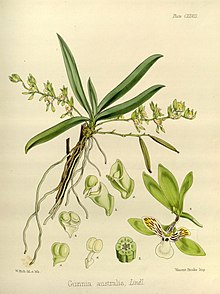| Butterfly orchid | |
|---|---|

| |
| Illustration from Hooker's Flora Antarctica | |
| Scientific classification | |
| Kingdom: | Plantae |
| Clade: | Tracheophytes |
| Clade: | Angiosperms |
| Clade: | Monocots |
| Order: | Asparagales |
| Family: | Orchidaceae |
| Subfamily: | Epidendroideae |
| Genus: | Sarcochilus |
| Species: | S. australis |
| Binomial name | |
| Sarcochilus australis (Lindl.) Rchb.f. | |
| Synonyms | |
Sarcochilus australis, commonly known as the butterfly orchid or Gunn's tree orchid, is a small epiphytic orchid endemic to eastern Australia. It has up to ten oblong, dark green leaves and up to fourteen small green to yellowish or brownish flowers with a mostly white labellum.
Description
Sarcochilus australis is a small epiphytic herb with a stem 20–50 mm (0.8–2 in) long with between three and ten dark green leaves 40–80 mm (2–3 in) long and 10–14 mm (0.4–0.6 in) wide. Between two and fourteen green to yellowish or brownish flowers 16–18 mm (0.6–0.7 in) long and 12–15 mm (0.5–0.6 in) wide are arranged on a pendulous flowering stem 70–160 mm (3–6 in) long. The sepals are 7–12 mm (0.3–0.5 in) long and 3–4.5 mm (0.1–0.2 in) wide whilst the petals are shorter and narrower. The labellum is white with purple and yellow markings, about 3 mm (0.1 in) long and 5 mm (0.20 in) wide and has three lobes. The side lobes are erect, usually with purple markings and the middle lobe erect with a thin, solid spur. Flowering occurs between October and January.
Taxonomy and naming
The butterfly orchid was first formally described in 1834 by John Lindley who gave it the name Gunnia australis and published the description in Edwards's Botanical Register. In 1863, Heinrich Gustav Reichenbach changed the name to Sarcochilus australis. The specific epithet (australis) is a Latin word meaning "southern".
Distribution and habitat
Sarcochilus australis grows on trees in rainforest and other humid places, sometimes close to the ground. It is found between the Hunter River in New South Wales through south-eastern Victoria to northern Tasmania.
References
- Hooker, Joseph Dalton (1860). The botany of the Antarctic voyage of H.M. discovery ships Erebus and Terror in the Years 1839-1843 :under the command of Captain Sir James Clark Ross. London: Lovell Reeve & Co. p. Pl. 128. Retrieved 3 January 2019.
- ^ ‹ The template below (WCSP) is being considered for deletion. See templates for discussion to help reach a consensus. ›
"Sarcochilus australis". World Checklist of Selected Plant Families (WCSP). Royal Botanic Gardens, Kew.
- ^ Jones, David L. (2006). A complete guide to native orchids of Australia including the island territories. Frenchs Forest, N.S.W.: New Holland. pp. 447–448. ISBN 1877069124.
- ^ Jeanes, Jeff. "Sarcochilus australis". Royal Botanic Gardens Victoria. Retrieved 3 January 2019.
- ^ Weston, Peter H. "Sarcochilus australis". Royal Botanic Garden Sydney. Retrieved 3 January 2019.
- "Gunnia australis". APNI. Retrieved 3 January 2019.
- Lindley, John (1835). "Oncidium ampliatum". Edwards's Botanical Register. 20: Pl.1699. Retrieved 3 January 2019.
- "Sarcochilus australis". APNI. Retrieved 3 January 2019.
- Brown, Roland Wilbur (1956). The Composition of Scientific Words. Washington, D.C.: Smithsonian Institution Press. p. 112.